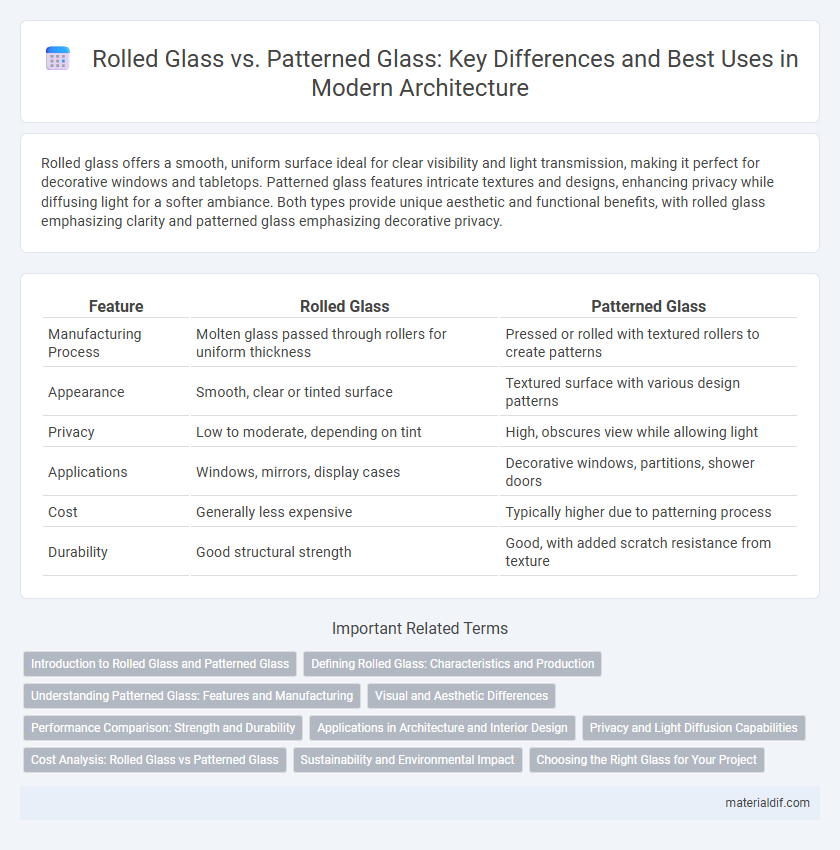Rolled glass offers a smooth, uniform surface ideal for clear visibility and light transmission, making it perfect for decorative windows and tabletops. Patterned glass features intricate textures and designs, enhancing privacy while diffusing light for a softer ambiance. Both types provide unique aesthetic and functional benefits, with rolled glass emphasizing clarity and patterned glass emphasizing decorative privacy.
Table of Comparison
| Feature | Rolled Glass | Patterned Glass |
|---|---|---|
| Manufacturing Process | Molten glass passed through rollers for uniform thickness | Pressed or rolled with textured rollers to create patterns |
| Appearance | Smooth, clear or tinted surface | Textured surface with various design patterns |
| Privacy | Low to moderate, depending on tint | High, obscures view while allowing light |
| Applications | Windows, mirrors, display cases | Decorative windows, partitions, shower doors |
| Cost | Generally less expensive | Typically higher due to patterning process |
| Durability | Good structural strength | Good, with added scratch resistance from texture |
Introduction to Rolled Glass and Patterned Glass
Rolled glass is produced by pouring molten glass onto a flat surface and then passing it through rollers to create a uniform thickness, often featuring smooth or textured patterns. Patterned glass, a subtype of rolled glass, incorporates embossed designs or textures during the rolling process to enhance privacy and decorative appeal. Both types offer versatility in architectural and interior design applications, balancing light transmission with aesthetic functionality.
Defining Rolled Glass: Characteristics and Production
Rolled glass is a type of textured glass created by pouring molten glass onto a metal table and passing it through rollers, which imprint specific patterns onto its surface. Unlike patterned glass, which may be molded or cast with intricate designs, rolled glass features continuous, repetitive textures that enhance privacy and diffuse light efficiently. Its manufacturing process allows for consistent thickness and varied surface patterns, making it ideal for decorative and architectural applications.
Understanding Patterned Glass: Features and Manufacturing
Patterned glass features unique surface textures created through a rolling process where molten glass passes between engraved rollers, imprinting specific designs that enhance privacy and aesthetic appeal. This manufacturing technique allows for diverse patterns like rain, reed, or linen, which diffuse light while obscuring visibility, making it ideal for windows, partitions, and decorative applications. Compared to rolled glass, which is typically smooth and flat, patterned glass offers functional benefits in light diffusion and style customization through its embossed surfaces.
Visual and Aesthetic Differences
Rolled glass features a smooth, uniform surface that offers high clarity and a sleek, modern look, making it ideal for minimalist design styles. Patterned glass incorporates textured or embossed designs that create decorative effects and diffuse light, enhancing privacy while adding visual interest. The choice between rolled and patterned glass significantly impacts a space's ambiance, balancing transparency and ornamentation.
Performance Comparison: Strength and Durability
Rolled glass typically offers enhanced durability and impact resistance due to its manufacturing process involving heat and pressure, making it stronger than standard patterned glass. Patterned glass, while aesthetically versatile with various embossed designs, often exhibits lower strength and is more prone to scratches and surface wear. For applications requiring high performance in terms of strength and longevity, rolled glass is generally the preferred choice.
Applications in Architecture and Interior Design
Rolled glass offers a smooth, uniform surface ideal for modern architectural facades and minimalist interior partitions, enhancing natural light while maintaining structural clarity. Patterned glass features textured designs that provide privacy without compromising light transmission, making it suitable for decorative windows, shower enclosures, and office dividers. Both types serve functional and aesthetic roles, with rolled glass emphasizing sleekness and patterned glass optimizing visual interest and obscurity in residential and commercial spaces.
Privacy and Light Diffusion Capabilities
Rolled glass offers moderate privacy with a textured surface that gently diffuses light, creating a soft glow while still allowing visibility. Patterned glass provides enhanced privacy through intricate designs that obscure views more effectively, making it ideal for bathrooms or office partitions. Both types balance light diffusion and privacy, but patterned glass typically delivers greater opacity without sacrificing natural light.
Cost Analysis: Rolled Glass vs Patterned Glass
Rolled glass generally offers a lower cost compared to patterned glass due to its simpler manufacturing process, involving the continuous pressing of molten glass. Patterned glass, which requires intricate molds or rollers to create specific textures and designs, typically incurs higher production expenses that are reflected in its price. For projects prioritizing budget, rolled glass provides an economical choice, while patterned glass offers added aesthetic value at a premium cost.
Sustainability and Environmental Impact
Rolled glass and patterned glass differ significantly in sustainability and environmental impact; rolled glass production typically requires higher energy due to the heating and rolling processes, whereas patterned glass often incorporates recycled materials, reducing raw material consumption. Patterned glass enhances energy efficiency through better insulation properties, contributing to lower heating and cooling demands in buildings. Both types can be recycled, but the textured surface of patterned glass may offer additional benefits in reducing waste by extending the glass's functional lifespan.
Choosing the Right Glass for Your Project
Rolled glass offers a smooth, uniform surface ideal for applications requiring clarity and strength, while patterned glass provides textured designs for enhanced privacy and decorative appeal. Selecting the right glass depends on the project's functional needs, such as visibility, light diffusion, and aesthetic preferences. Consider factors like durability, maintenance, and the environment where the glass will be installed to achieve optimal performance and style.
Rolled glass vs Patterned glass Infographic

 materialdif.com
materialdif.com